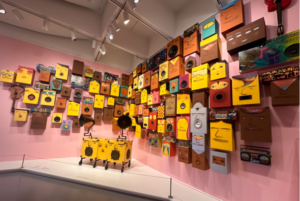The Metro is Broken: Ahhh!

Image Courtesy of ABC 7 Washington D.C.
On Tuesday, October 12, a blue line Metro train derailed three times, with the third derailment being just south of Rosslyn Station in Arlington, Virginia. The train held 187 passengers, who all evacuated safely. According to investigators, only one person was taken to the hospital with non-life-threatening injuries. After the derailment, the Washington Metropolitan Area Transit Authority (WMATA) pulled 748 subway cars in the 7000 series fleet that following Monday. Many people in the D.C., Maryland, and Virginia (DMV) area resorted to taking the bus, working from home, or waiting at train stations to ride an overcrowded and potentially dangerous train. WMATA launched an investigation and decided to remove over half of the Metro’s train cars. The question in this investigation would be, what could have caused the train to derail in the first place?
“The most basic way for a train to derail is because of the conical shape of the wheel on a train car. This is because in corners, without the slope, the train would rest on the flanges at the edge of the wheel, and derail,” said freshman engineering major James Wood. “The downside to this though is that at higher speeds, the wheels must rotate at the same rate that the train axles are designed. Train axles do not have a differential, which is a component that allows the wheels of the train to rotate at different speeds, whereas any normal car will have a differential to allow for tight cornering, a train does not.”
The Metro would run about 98 trains out of the 1,200 cars in its entire fleet on all of its lines every weekday. Since the investigation started, the number of trains has been reduced, because WMATA is only using their older train models for the time being. This means that the trains now take fifteen to twenty minutes instead of the trains arriving less than ten minutes apart. With the Metro breaking down, it does send a message to other regional train systems across the country and even the world. The Kawasaki Rail Car Incorporation designed all the Metro cars, and they even designed the subway cars for the Metropolitan Transit Authority in New York City.
“When looked into a bit more, it looks that the axles made for the D.C. Metro were out of spec, being too short or too long for the design specifications. I would believe to infer that there are quality control issues,” Wood said. “If I were someone in the management of another Metro system that uses Kawasaki branded cars, I would probably ensure that the parts that keep my cars on the rails are in spec. With that being said though, any Metro system that is in charge of transporting millions of passengers annually should be inspecting its cars at least once or twice every year.”
This isn’t the first time the Metro has derailed. In 2017, a Metro train that had the same model cars derailed with the same car design. The derailment was under federal investigation and investigators discovered that the train derailed because of the way the wheels were assembled. Since the derailment in 2017, there have been two failures with the same train cars in 2017 and 2018, four in 2019, and five in 2020. This year marks the first action the WMATA has taken on derailed cars.
“The fact that WMATA knew about the issue before this event is not all that surprising. The number of these aberrations since then has increased to 18 in 2021 found by WMATA’s normal checks, and since the derailment, there have been 21 more axles that have been found out of the manufacturer’s intended width,” Wood said. “All that WMATA can really do about it is figure out why some of the axles are expanding, and try to either replace or modify the current assembly to rectify the current issue, and then check in on each car’s axle spec with a greater frequency than they were before.”
So far during the investigation, WMATA has been looking at data from recent inspections on the particular train model that derailed. Investigators have been mainly focusing on the assembly of the wheels because that was the cause in 2017. What investigators and WMATA is hoping for, is to find a process where they can safely return their 7,000 series fleet back to operation. The question is how often the wheel cars of the train will need to be inspected and making sure that the inspection is effective.
“With that being said though, WMATA seems to have an innate ability to never run things to schedule,” Wood said. “If the derailment from 2017 is any precedent, we likely won’t be hearing from the NTSB for a good while.”







